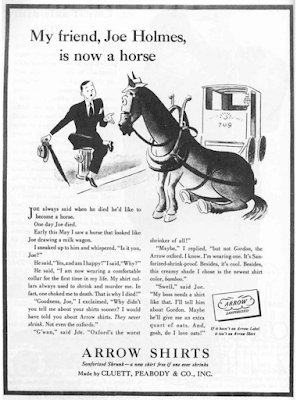Storytelling in advertising, reincarnated
We know storytelling is all the rage now in marketing. And like most fashionable things, there’s usually some precedent in the past. Why else do we have the phrase, “Everything old is new again”?
Still, you’re not likely to come across a story today like the one in this 1938 Arrow Shirts ad. If authenticity is all, this is more, well, horseplay:
It was written by George Gribbin of Young & Rubicam, who was recalled as saying, "One of the great assets of this agency is that a man here feels he can express himself as a writer." Certainly, he accomplished that here; sixty years later, the ad was still well remembered, ranking 98th of the Top 100 Ads according to Advertising Age magazine in 1999. It begins,
Joe always said when he died, he’d like to become a horse.
One day Joe died.
Early this May, I saw a horse that looked like Joe drawing a milk wagon. “I sneaked up to him and whispered, “Is it you, Joe?”
He said “Yes, and am I happy!” I said, “Why?” He said, “I am now wearing a comfortable collar for the first time in my life. My shirt collars always used to shrink and murder me. In fact, one choked me to death. That is why I died.”
“Goodness Joe,” I exclaimed, “Why didn’t you tell me about your shirts sooner? I would have told you about Arrow Shirts. They never shrink.”
Admittedly, the idea that a man found relief from the strictures of business wear as a horse yoked to a heavy wagon isn’t really a persuasive argument. But, by drawing you in and keeping your interest, it made Arrow’s point.
Before advertising started emphasizing word play, humor, visual appeal, and shock value in the second half of the last century, storytelling was a staple of many an ad campaign. And when I say “story,” I’m talking epics. Ads would routinely feature long paragraphs of copy, mimicking the dense, tightly-spaced copy of the newspapers of the era. This was also the pre-television era when people were willing to invest a considerable amount of time reading columns of copy in ads – assuming the story hooked them up front.
Perhaps you're aware of this classic of the genre, circa 1925:
I’ll bet that headline still draws you in with its cliffhanger ending, even if the look and layout of the ad is off-putting to modern eyes.
It was written early in his career by John Caples, later revered as a master of mail-order advertising (and a pioneer in applying scientific methods for testing advertising). The ad here, Caple’s best-known, is a sterling example of how he yoked storytelling to “the more you tell, the more you sell” of direct-response copy.
I’ll save you the squinting and nose prints on your computer screen – here's the gist of the copy:
To the amazement of all my friends, I strode confidently over to the piano and sat down. ... The crowd laughed. They were all certain I couldn’t play a single note. …
Then I started to play. A tense silence fell on the guests. The laughter died on their lips as if by magic. I played through the first bars of Beethoven’s immortal Moonlight Sonata. I heard gasps of amazement. My friends sat breathless, spellbound. …
Then I told them the whole story. “Have you ever heard of the U.S. School of Music? I asked.
As Julian Lewis Watkins recounts in his book, The 100 Greatest Advertisements: Who Wrote Them and What They Did, “The ad was an astonishing success, bringing in a record number of coupons. … It went on to run in other publications for several years and was much imitated.”
Though not really an imitator, the Arrow Shirts ad is built from the same DNA (Deft Narrative Advertising, perhaps) of hooking the reader with an engaging story and irresistible headline. But instead of aping the look of turn-of-the-century newspapers, this ad looks more like a piece of mid-century magazine fiction – and appropriately, tells a more fanciful tale as well.
George Gribben also applied his talent (and his skewed imagination) to ads for Borden’s dairy products. He didn’t create Elsie, the bovine homemaker and milk pusher – that was David William Reid – but in the 1940s, Gribben was responsible for a number of whimsical ads that took advertisement storytelling into a bizarre faux children’s-book realm.
I don’t know if he wrote the ad below, but I like to think Gribben did it as a kind of rejoinder to his earlier “Joe Came Back as a Horse” ad:
“Haven’t I told you never to trust a horse?” snapped Elsie.






Comments